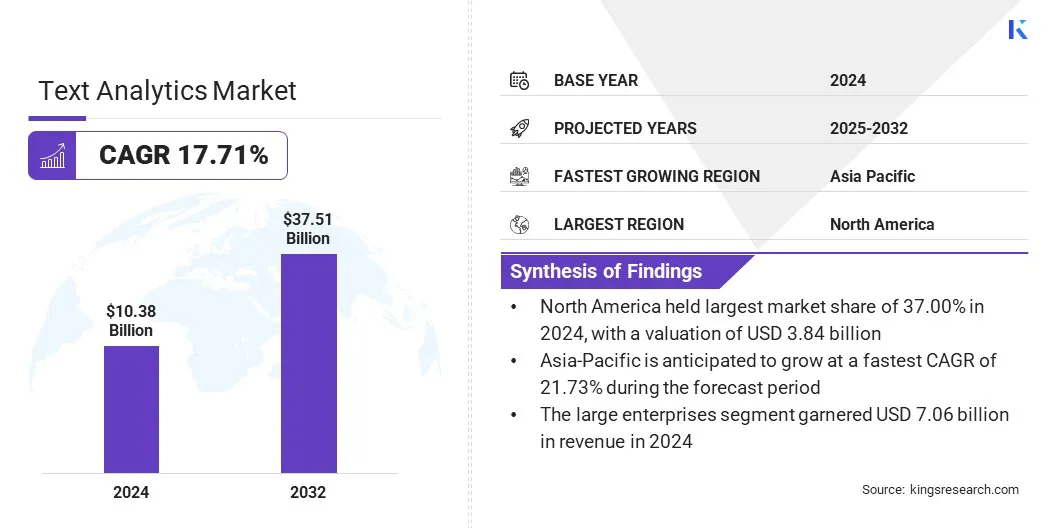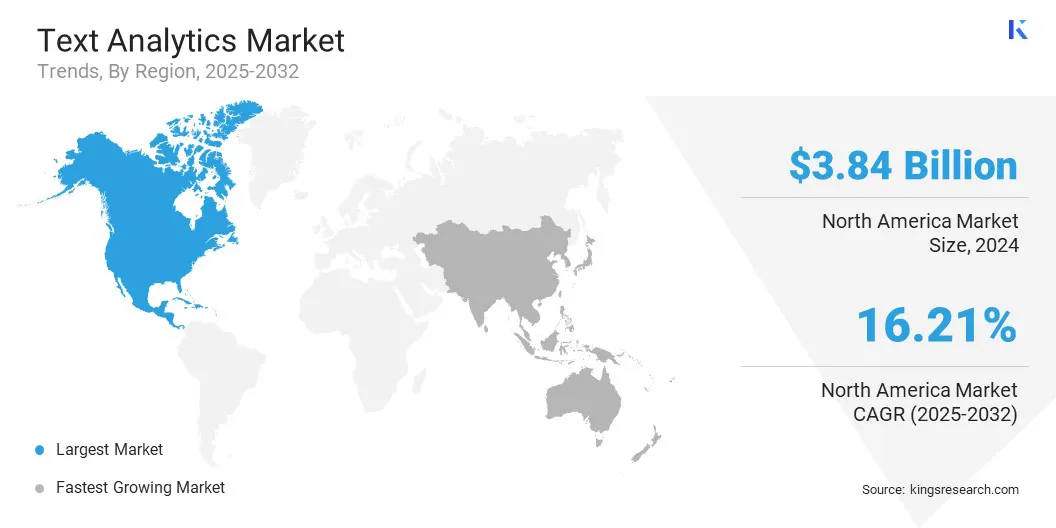Buy Now
Text Analytics Market Size, Share, Growth & Industry Analysis, By Deployment Mode (On-Premise, Cloud-Based), By Organization Size (Large Enterprises, Small & Medium Enterprises (SMEs)), By Application (Customer Experience Management, Fraud Detection & Risk Management), By Industry Vertical, and Regional Analysis, 2025-2032
Pages: 210 | Base Year: 2024 | Release: July 2025 | Author: Versha V.
Text analytics is the process of deriving structured insights from unstructured text using natural language processing, machine learning, and statistical analysis. They allow organizations to identify patterns, extract key information, and interpret sentiments from sources such as customer reviews, emails, social media, and documents.
Text analytics solutions are widely used in customer experience management, fraud detection, compliance monitoring, and market intelligence. The market also supports applications in healthcare, finance, and e-commerce, where timely insights from textual data improve decision-making, operational efficiency, and strategic planning.
The global text analytics market size was valued at USD 10.38 billion in 2024 and is projected to grow from USD 11.98 billion in 2025 to USD 37.51 billion by 2032, exhibiting a CAGR of 17.71% during the forecast period.
This growth is attributed to the rising adoption of text analytics solutions across key end-use sectors such as retail, healthcare, BFSI, and telecommunications. Increasing demand for real-time insights, sentiment analysis, and customer experience optimization is driving the deployment of these tools in marketing, compliance monitoring, and risk management applications.
Major companies operating in the global text analytics market are IBM, Microsoft, SAP SE, Lexalytics (an InMoment Company), Qualtrics, Open Text Corporation, LUMINOSO TECHNOLOGIES, INC., SAS Institute Inc., Infegy, Inc., Medallia Inc., Megaputer Intelligence Inc., Oracle, Cloud Software Group, Inc., Bitext Innovations Inc., and BasisTech.

|
Segmentation |
Details |
|
By Deployment Mode |
On-Premise, Cloud-Based |
|
By Organization Size |
Large Enterprises, Small & Medium Enterprises (SMEs) |
|
By Application |
Customer Experience Management, Fraud Detection & Risk Management, Competitive Intelligence, Marketing & Sales Management, Workforce Management, Social Media Monitoring, Predictive Analytics, Content Management, Other Applications |
|
By Industry Vertical |
BFSI (Banking, Financial Services & Insurance), Retail & E-commerce, Healthcare & Life Sciences, Government & Defense, IT & Telecom, Media & Entertainment, Education, Manufacturing, Transportation & Logistics, Others |
|
By Region |
North America: U.S., Canada, Mexico |
|
Europe: France, UK, Spain, Germany, Italy, Russia, Rest of Europe |
|
|
Asia-Pacific: China, Japan, India, Australia, ASEAN, South Korea, Rest of Asia-Pacific |
|
|
Middle East & Africa: Turkey, U.A.E., Saudi Arabia, South Africa, Rest of Middle East & Africa |
|
|
South America: Brazil, Argentina, Rest of South America |
Based on region, the market has been classified into North America, Europe, Asia Pacific, Middle East & Africa, and South America.

North America text analytics market share stood at 37.00% in 2024, valued at USD 3.84 billion. This dominance is attributed to the region’s widespread adoption of advanced analytics solutions, the presence of leading text analytics vendors, and high digital transformation across industries such as BFSI, healthcare, and retail.
Furthermore, increasing investment by enterprises and government agencies in artificial intelligence, cloud infrastructure, and customer intelligence platforms is driving the deployment of text analytics solutions across commercial and public sectors.
The region’s emphasis on real-time data analysis, personalized customer engagement, and strict regulatory compliance further reinforces its leadership in the market. Growing demand for predictive analytics, multilingual processing capabilities, and integration with business intelligence tools along with continuous innovation in natural language processing technologies, supports sustained regional market expansion.
The Asia-Pacific text analytics industry is set to grow at a CAGR of 21.73% over the forecast period. This growth is supported by the region’s accelerating digital transformation and increasing reliance on data-driven decision-making across industries. Expanding internet connectivity, rising adoption of cloud platforms, and the proliferation of digital communication channels are creating a strong demand for real-time and scalable text analytics solutions.
Government-backed digitalization efforts, combined with rapid developments in e-commerce, telecom, and financial services, are further advancing the market across Asia-Pacific.
Moreover, the growing need for multilingual processing, automation in customer interaction, and AI integration in enterprise systems is driving adoption across both emerging and developed economies. Additionally, organizations are increasingly implementing advanced text analytics tools to improve operational efficiency, enhance personalization, and meet compliance requirements across the region.
The growing emphasis on data-driven decision-making, operational efficiency, and personalized engagement is fueling market expansion. Additionally, ongoing advancements in artificial intelligence, natural language processing, and cloud-based analytics platforms, along with the surge in unstructured data from digital channels, are accelerating market development.
Surge in Unstructured Data Across Digital Channels
The progress of the text analytics market is propelled by the surge in unstructured data generated across a growing number of digital channels. Organizations are handling massive volumes of text-based inputs from emails, social media platforms, chat transcripts, customer reviews, and web content, which lack a standardized structure.
Traditional data tools fall short in managing and interpreting this information, increasing the demand for text analytics solutions that can deliver contextual understanding and extract meaningful insights.
The need to make informed, real-time decisions is intensifying across industries, prompting greater investment in artificial intelligence and natural language processing technologies. Businesses are turning to text analytics to enhance customer experience, optimize operations, and gain a competitive edge, which continues to drive strong market growth.
Limited Accuracy in Multilingual and Domain-Specific Applications
Limited accuracy in multilingual and domain-specific applications presents a significant barrier to the widespread adoption of text analytics solutions. Many platforms struggle to interpret industry-specific terminology, technical language, and context-sensitive expressions leading to reduced insight quality in sectors such as healthcare, legal, and finance.
Additionally, language diversity including low-resource languages and regional dialects complicates text processing, often resulting in inconsistent sentiment analysis, entity extraction, and intent recognition across geographies and user bases. These limitations reduce the overall effectiveness of text analytics solutions and restrict their full potential in specialized and multilingual environments.
Overcoming this challenge requires the use of multilingual NLP models trained on domain-specific datasets to enhance contextual accuracy. Techniques such as transfer learning, language localization, and human-in-the-loop validation are being adopted to improve performance. These advancements enable reliable insights and support wider adoption across specialized sectors and diverse linguistic environments.
Advancements in Artificial Intelligence and Natural Language Processing
Advancements in artificial intelligence and natural language processing are transforming the text analytics market by enabling deeper contextual analysis, faster data processing, and more accurate interpretation of language.
Innovations in deep learning, transformer-based models, and semantic understanding are allowing text analytics platforms to detect sentiment, identify intent, and extract key entities with high precision across diverse text formats. These technologies are enhancing solution capabilities in applications such as customer sentiment analysis, compliance monitoring, and market intelligence.
The integration of machine learning algorithms enables continuous improvement through data-driven learning, while multilingual processing capabilities support global deployment. Additionally, real-time text processing and intelligent automation are improving responsiveness and decision-making across industries.
The development of scalable, cloud-based platforms with advanced NLP features is driving widespread adoption in sectors such as healthcare, finance, retail, and telecommunications. .
The text analytics industry is characterized by the presence of several established technology leaders and emerging analytics providers competing based on platform innovation, natural language processing capabilities, and industry-specific solutions. Key market participants are focusing on advancements in artificial intelligence, machine learning models, and multilingual processing to improve analytical accuracy, scalability, and real-time performance.
Companies are also investing in research and development to create adaptive, cloud-based solutions tailored to the specific needs and language of industries such as BFSI, healthcare, retail, and telecommunications.
Furthermore, strategic partnerships with cloud service providers, system integrators, and enterprise software vendors, along with mergers and acquisitions are being pursued to enhance global presence, accelerate product innovation, and expand application reach across compliance monitoring, customer engagement, and competitive intelligence.
Frequently Asked Questions